In Chapter 9, we explore advanced OSPF features, including Area Border Routers (ABRs), Link-State Advertisements (LSAs), and route summarization. These features make OSPF suitable for large, scalable networks by reducing routing overhead and improving network efficiency. This chapter covers OSPF’s backbone, LSA types, inter-area routing, path selection, and more.
🌐 OSPF Backbone (Area 0)
The OSPF backbone is designated as Area 0, and it’s essential for inter-area routing. All other areas must connect to Area 0 to facilitate efficient routing across the OSPF domain, helping to maintain a loop-free topology.
Key Concept: Always connect non-backbone areas directly to Area 0. If a direct connection isn’t possible, configure a virtual link to extend the backbone.
🧩 Area Border Routers (ABRs)
Area Border Routers (ABRs) are critical in OSPF as they connect different areas, allowing the exchange of routing information between them. ABRs help reduce routing complexity by summarizing and filtering routes between areas.
To configure an ABR, place it in both Area 0 and at least one other area using the network command:
Router(config-router)# network <network_address> <wildcard_mask> area <area_id>
For example:
Router(config-router)# network 10.1.1.0 0.0.0.255 area 0Router(config-router)# network 10.2.1.0 0.0.0.255 area 1
📜 OSPF Area ID
OSPF organizes networks using Area IDs, which help limit the scope of routing updates and reduce SPF calculation complexity. You can specify Area IDs in decimal or dotted-decimal notation (e.g., 0 or 0.0.0.0 for Area 0).
To assign an interface to a specific area:
Router(config-router)# network <network_address> <wildcard_mask> area <area_id>
📄 Link-State Advertisements (LSAs) and LSA Types
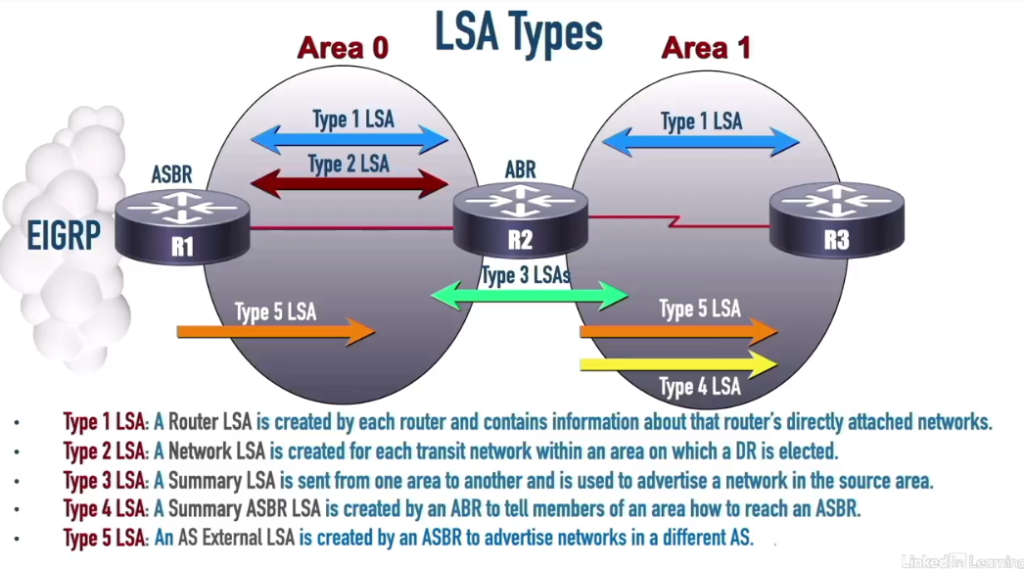
OSPF routers use Link-State Advertisements (LSAs) to share network topology information. LSAs allow OSPF to dynamically discover and update the network map. Here are the main types of LSAs used in OSPF:
Type 1 LSA: Router LSA
Type 1 LSAs are generated by each router and describe the router’s links and link costs within an area.
Type 2 LSA: Network LSA
Type 2 LSAs are generated by the Designated Router (DR) on broadcast and non-broadcast networks, describing all routers on the segment.
Type 3 LSA: Summary LSA
Generated by ABRs, Type 3 LSAs summarize IP networks from one area to another, reducing the size of the OSPF database.
To view LSAs in a specific area:
show ip ospf database
Note: Understanding LSAs is key to troubleshooting OSPF and optimizing network performance.
Stub area
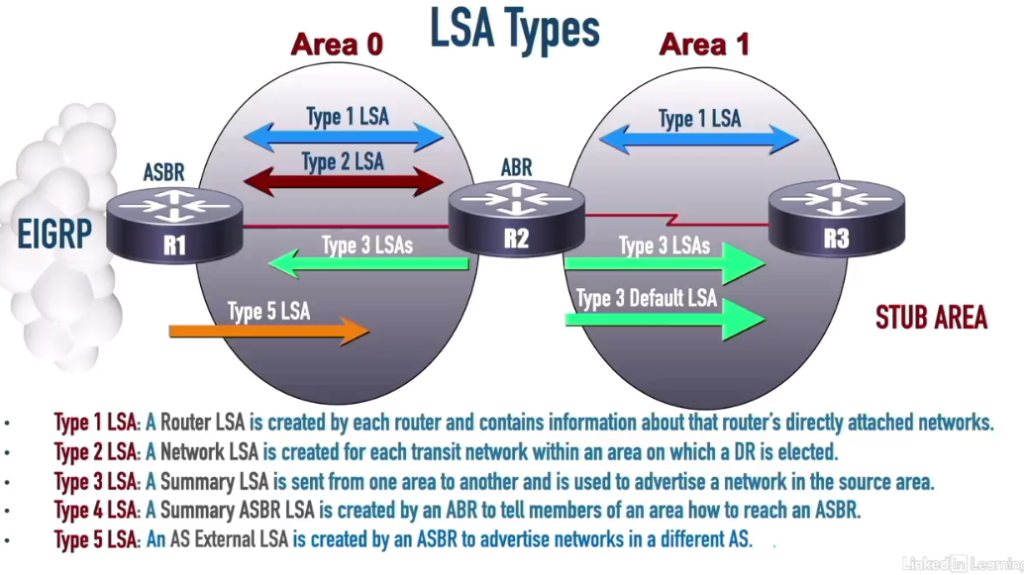
Totally Stubby
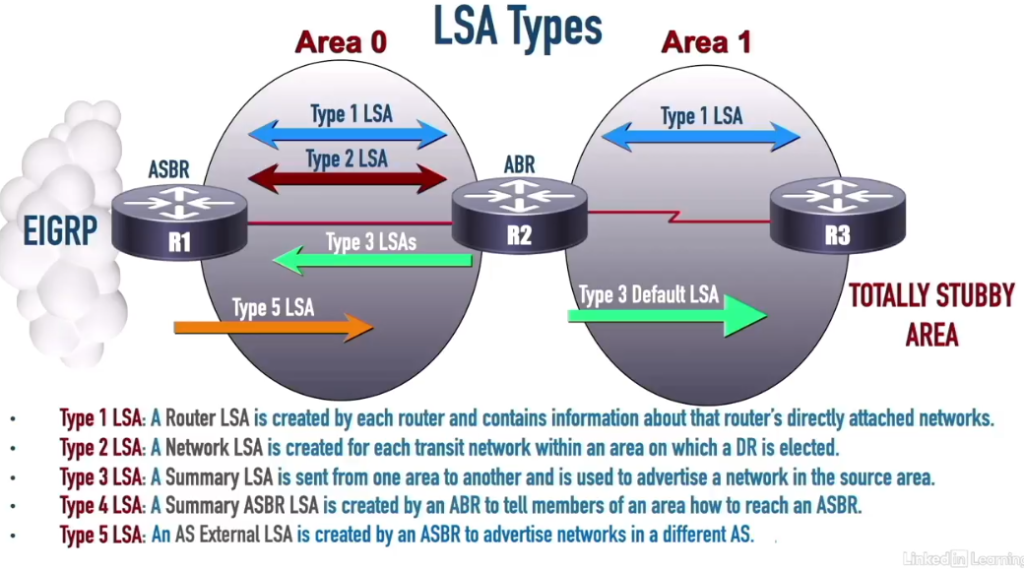
NSSA Area

Totally NSSA
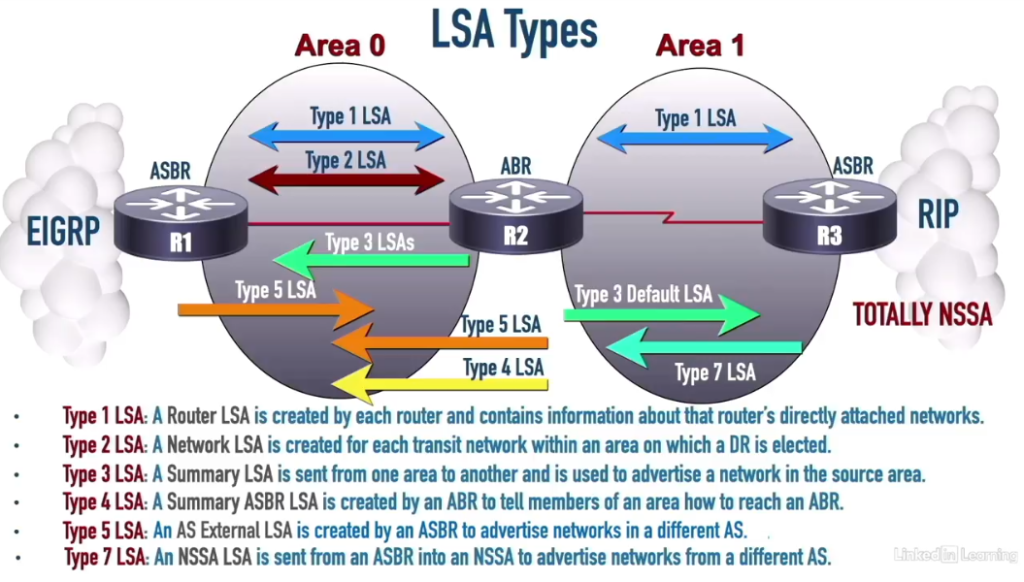
🔄 LSA Flooding and Path Selection
OSPF floods LSAs throughout an area to ensure that all routers maintain an up-to-date topology map. OSPF uses the Shortest Path First (SPF) algorithm to calculate the best path based on link costs, which is determined by the bandwidth of each link.
To adjust the cost of an OSPF link:
Router(config-if)# ip ospf cost <cost_value>
For example, to set a link cost of 10:
Router(config-if)# ip ospf cost 10
Tip: Lowering the cost makes a path more favorable for OSPF routing.
📦 OSPF Route Summarization
Route summarization combines multiple routes into a single summary route, reducing the number of LSAs and minimizing OSPF database size. Summarization can occur on ABRs (for inter-area routes) or ASBRs (for external routes).
Inter-Area Summarization:
To configure summarization on an ABR:
Router(config-router)# area <area_id> range <summary_address> <subnet_mask>
For example, to summarize networks 10.1.0.0/16 and 10.2.0.0/16 into 10.0.0.0/8:
Router(config-router)# area 1 range 10.0.0.0 255.0.0.0
External Route Summarization:
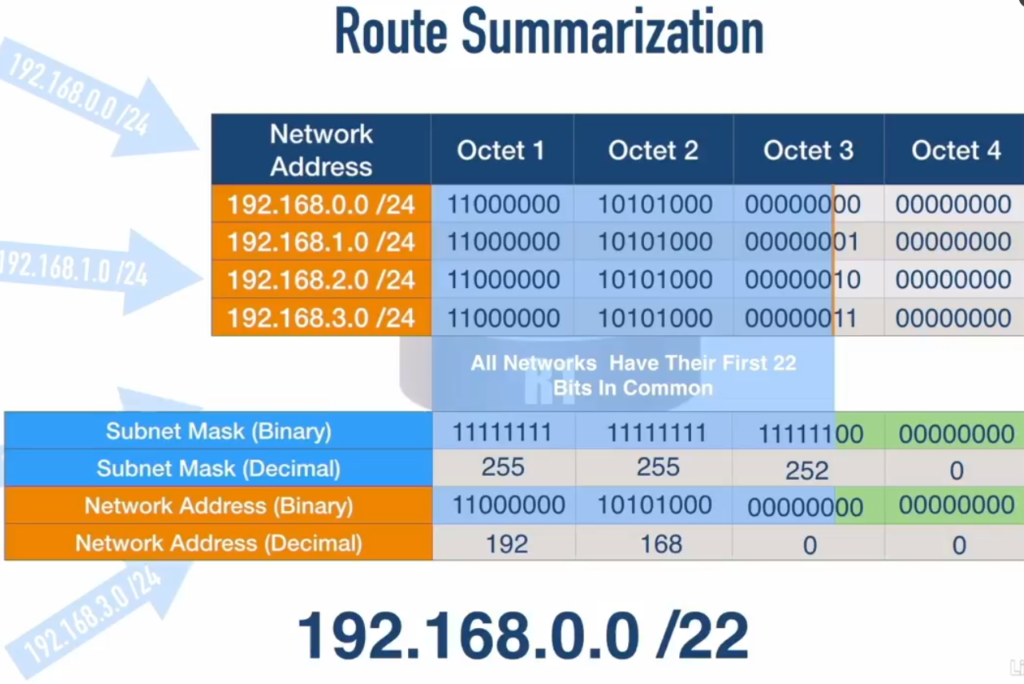

To configure summarization on an ASBR:
Router(config-router)# summary-address <summary_address> <subnet_mask>
To configure summarization on an ABR:
Router(config-router)# Area <id From> <summary_address> <subnet_mask>
🚦 OSPF Default Route Advertisement
You can advertise a default route in OSPF by using the default-information originate command, which allows OSPF to propagate the default route to other routers within the OSPF domain.
To configure default route advertisement:
Router(config-router)# default-information originate
This command is especially useful in hub-and-spoke topologies, where the hub provides internet access to spoke routers.
🔍 OSPF Area Filtering
Area filtering controls which routes are advertised between areas, helping reduce unnecessary routing information. Filtering is often configured on ABRs to optimize inter-area communication.

To configure OSPF area filtering:
Router(config-router)# area <area_id_to_or_from> filter-list prefix <prefix_list_name> in | out
For example, to filter routes from Area 1 to other areas:
Router(config-router)# area 1 filter-list prefix BLOCK_ROUTES out- ip prefix list Block_ROUTES seq 10 deny x.x.x.x
ip prefix list Block_ROUTES seq 10 permit 0.0.0.0/0 le 32
⏱️ OSPF Convergence
OSPF convergence speed depends on Hello and Dead intervals, which determine how often routers send Hello packets and how long they wait before declaring a neighbor down.
To adjust OSPF Hello and Dead intervals:
Router(config-if)# ip ospf hello-interval <seconds>Router(config-if)# ip ospf dead-interval <seconds>
Faster convergence can be achieved by reducing these intervals, but this also increases network overhead.
🌐 OSPF Network Types
OSPF supports various network types, each with specific behaviors and requirements:
- Broadcast: Used for Ethernet, with DR/BDR elections.
- Non-Broadcast: For networks like Frame Relay, requires DR/BDR elections and manual neighbor configuration.
- Point-to-Point: Direct links that don’t require DR/BDR elections.
- Point-to-Multipoint: Treats all links as point-to-point; no DR/BDR needed.
To manually configure the network type on an interface:
Router(config-if)# ip ospf network {broadcast | non-broadcast | point-to-point | point-to-multipoint}
📋 Summary
In Chapter 9, we explored advanced OSPF configurations, focusing on LSAs, ABRs, route summarization, and network types. Here’s a summary:
- OSPF Backbone: Area 0 serves as the central area for inter-area routing.
- ABRs and LSAs: ABRs connect areas and control the flow of routing information through different LSA types.
- Route Summarization: Summarizing routes reduces the size of the OSPF database and improves efficiency.
- Default Route Advertisement: Use
default-information originateto propagate a default route. - Area Filtering: Control which routes are advertised between areas to optimize routing.
- Network Types: OSPF supports multiple network types, such as Broadcast, Non-Broadcast, Point-to-Point, and Point-to-Multipoint.
These advanced OSPF concepts make the protocol scalable and efficient for complex enterprise networks

